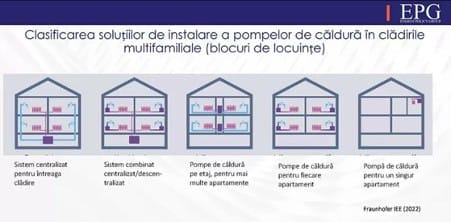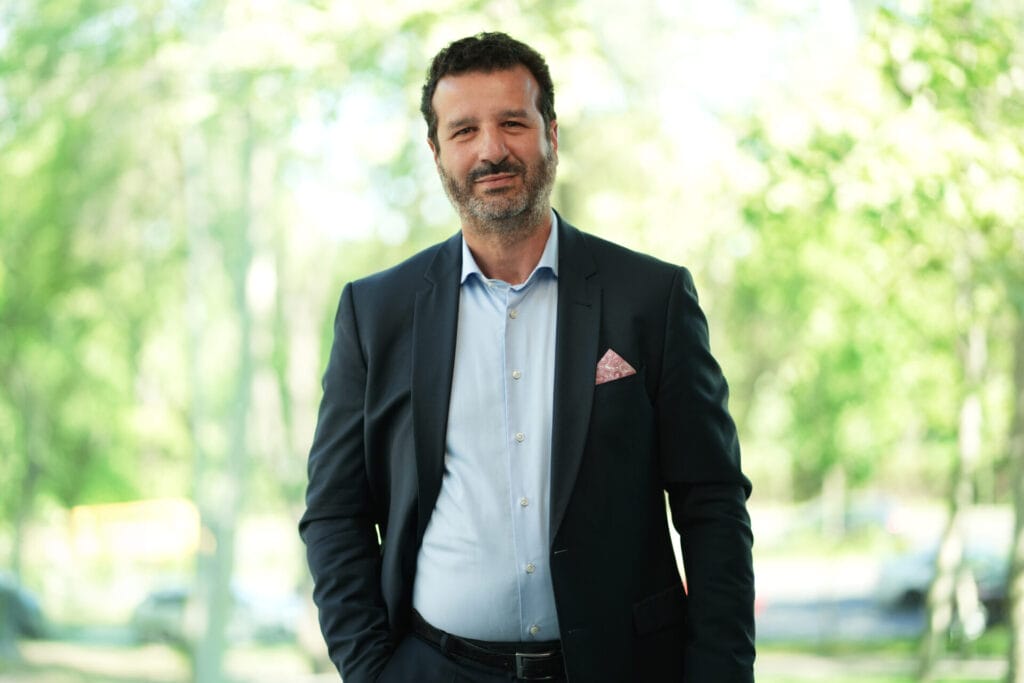Even before the Russo-Ukrainian conflict, the European Union countries recognized the need to reduce carbon emissions, contribute to mitigating climate change, and implement technological solutions to achieve these goals.
Against the backdrop of the current energy crisis, heat pumps can play a crucial role in efforts to decrease dependence on natural gas. This need is driven by concerns over climate impact, rising prices, and the geopolitical implications associated with the source of natural gas.
In other words, why does it seem that we’ve only recently discovered heat pumps even though they’ve existed for decades? And why do so few of us have them in our homes, despite being a primary low-carbon alternative to gas-powered heating systems?
What are heat pumps?
Heat pumps are one such technological option and one of the simplest heating solutions. They can be relatively easily installed, don’t require natural gas, and utilize renewable sources to function. A heat pump is an electric system that efficiently and sustainably extracts thermal energy from one location (the external environment – air, ground, water) and transfers it to another.
Its operation is based on the second law of thermodynamics, which states that heat cannot spontaneously transfer from a colder location to a warmer one without additional energy input.
In heat pumps, this additional energy is supplied by a compressor and transferred by a substance called a refrigerant, which undergoes a cycle of evaporation and condensation.
A heat pump consists of an outdoor unit and an indoor unit, between which the refrigerant circulates, transferring heat by changing its state from liquid to gas and vice versa.
Why are they important for energy savings and carbon emissions reduction?
Because they don’t generate heat but transfer it from one location to another, heat pumps use less energy to heat a home compared to conventional electric or gas systems. This makes them the most efficient method for providing heating (and cooling): even at temperatures we consider low, air, water, and soil contain amounts of heat that heat pumps can capture and that are replenished by the sun. With a small amount of electric energy input, the pump will bring this thermal energy to the desired level and supply it to the building being heated.
For every kW of electric energy consumed by a heat pump, approximately 4 kW of thermal energy is generated, and this coefficient tends to increase as technology evolves. Therefore, heat pumps are already highly energy-efficient. In addition to their energy efficiency performance, heat pumps contribute to reducing greenhouse gas emissions. Of course, the way the electricity used by them was produced matters, but it remains essential that, instead of using energy to generate heat, heat pumps take existing heat from one (natural) environment and transfer it to another (anthropogenic).

Myths about heat pumps
Numerous beliefs circulate in the public space regarding heat pumps, and it’s worth clarifying some of them.
Heat pumps don’t work well in cold areas
Tests show that heat pumps continue to operate efficiently at temperatures as low as -20°C, making this technology suitable for locations with colder climates. They can even function at lower temperatures, although they might require a higher input of electric energy.
You must have a well-insulated home before installing a heat pump
While it’s true that a well-insulated home will make a heat pump more efficient, it’s not mandatory to have insulation in place to use a heat pump. With the right system and installation, heat pumps can work successfully in large, well-ventilated, thermally uninsulated buildings, including grand structures dating back to the 1700s, churches, and cathedrals.
Heat pumps are noisy
These concerns originated from the time when heat pumps first appeared on the market and were bulky and relatively noisy. However, after years of research and innovation, modern heat pumps are compact, efficient, and no louder than a refrigerator or freezer. When in operation, they produce a hum of around 40 – 60 decibels (equivalent to the level of a conversation between two people standing 1 meter apart or the average noise level in a restaurant). The sound comes from the pump’s fan. It’s important to have them installed by certified technicians to avoid any potential noise issues resulting from imperfect installation.
Heat pumps need to run constantly
This myth might have arisen from the installation of heat pumps in thermally uninsulated buildings. In such cases, due to heat losses, the heat pump might need to run continuously to maintain the desired temperature level. However, in well-insulated buildings, the heat pump will initially warm up the entire space and then only turn on when necessary to maintain the desired temperature.
Heat pumps require a lot of maintenance
In reality, they require very little. All that’s needed is to ensure the heat pump remains clean and that airflow isn’t obstructed. Depending on the manufacturer’s warranty, routine checks are generally carried out once a year, and if you follow the instructions received, you shouldn’t have any headaches for about 20 years.
Heat pumps only work with underfloor heating
It’s worth noting that heat pumps require more time (compared to gas boilers) to heat up the entire desired space. Therefore, a larger surface area is useful to achieve the desired temperature. This is because the heat pump heats the thermal agent to 35-40°C, compared to 60-65°C in a gas boiler. As a result, while a heat pump is more efficient and yields better results when connected to underfloor heating, it works very well with radiators as well (which need to be larger than those associated with gas boilers to provide the larger surface area mentioned earlier).
Heat pumps take up a lot of space
Even though heat pumps have a fair number of components (internal unit, external unit, sometimes underground pipes for geothermal types), they don’t occupy much space. It’s comparable to the space required for a gas boiler and/or air conditioning unit. In the case of pipes, they are installed underground, out of sight, as is the above-ground piping, which is mounted on a wall.
Heat pumps are only used for heating
Despite their name (“heat pumps”), the technology was designed to be used in two directions: transferring heat indoors during the colder season (for heating) and transferring heat from indoors during the warmer season (for cooling). Additionally, heat pumps can be equipped with units for heating domestic water.
Heat pumps can only be installed in new buildings
Apartments, houses, office buildings, schools, swimming pools, and many other types of new or existing buildings can be equipped with heat pumps. The level of effort required (financially, in terms of time, technically) will depend on the existing heating system and the type of pump chosen. Based on whether there’s thermal insulation or not, the heat requirement will be calculated, and the installer will determine the size of the pump needed.
Heat pump technology is too new and hasn’t been tested
In fact, the first heat pumps were built 150 years ago. Although initially used for salt extraction, in the 1950s heat pumps began to be installed as heat sources in homes. The oil crisis of the 1970s spurred the growth of heat pump technology, and today there’s no doubt that it will become the primary method for capturing heat and more.
Limitations and constraints – not everything is rosy
Indeed, we must consider several aspects that are just as important as everything we’ve discussed so far. First and foremost, there’s the cost of acquisition and installation, which remains high. They depend on the brand and type of pump, with those using geothermal sources being the most expensive and potentially reaching several thousand euros for a single unit. This is the primary reason why heat pumps are not yet widely installed and why most people are still hesitant. Additionally, gas boilers are available at significantly lower costs, and even though the expenses can become considerable after installation, consumers tend to be most influenced by the initial investment.
Moreover, transitioning from a gas central heating system to a heat pump in older buildings involves other costs as well, such as those related to the rehabilitation of the interior electrical installation and thermal insulation of the structure, and potentially changing radiators to underfloor heating. Indeed, all these investments promise increased comfort afterward, lower monthly costs, and high energy efficiency… but it involves making a decision to invest a lot today for the promise of a more profitable future, and for many people, this decision is not an easy one to make.
Furthermore, even if we manage to overcome the financial obstacle, it still takes frustratingly long to get our hands on the long-awaited pump. Adding to the frustration is the fact that suppliers often can’t even provide us with a delivery date, and we’ll have to wait somewhere between 3 months and a year because it seems that production flows still can’t meet demand in a predictable manner.
Where is the best place to install heat pumps?
Considering all aspects related to installing a heat pump, it becomes clear that it would be most straightforward to install it in a single-family home or duplex. In such a scenario, the chances are higher that we would have adequate space both for the equipment itself and (if needed) for any necessary drilling/excavation/water reservoirs. Anticipating the argumentation in favor of public subsidies for heat pump installation, these subsidies could increase proportionally with the efficiency of the chosen equipment.
That being said, however, heat pumps can also be installed for multi-family residences, including apartment buildings. Public initiatives in this regard are already in place in Sectors 1 and 3 of Bucharest; the respective local administrations intend to subsidize up to 90% of the investment cost for installing heat pumps (and photovoltaic panels) in several hundred apartment buildings. It helps if there is already a district/area/sector heating system, but even in its absence, heat pumps can be installed at the building or apartment level.
It’s possible for larger-sized heat pumps to emerge, installed at the quarter level, serving multiple apartment buildings. Having a building with at least an energy performance class of D helps, and if not, investments should be made to reach the minimum level. In terms of a time horizon, it’s expected that urban areas will develop in the initial phase (most likely, in rural areas, biomass will remain a preferred heating method for some time), with a focus on residential areas (and non-residential areas coming later).
Regulatory and subsidy conditions required for widespread adoption of heat pumps
Currently, the regulatory framework in Romania is inadequately prepared and equipped to catalyze a widespread implementation of heat pumps. The energy market structure, characterized by price caps for households for both electricity and natural gas, discourages the use of heat pumps as they can lead to electricity consumption in households exceeding the subsidized monthly quantity.
As a result, despite being energy-efficient, heat pumps in Romania do not enjoy favorable economic conditions. Customers do not receive any subsidies for their purchase, nor do they benefit from attractive tariffs for the electricity used to operate the pumps.
Equally important is the fact that the political environment is marked by a weak understanding of what heat pumps are, the type of benefits they bring, as well as the technical, infrastructural, and economic conditions required for their adoption. Misconceptions prevail, and there are still not enough opinion leaders to educate and debunk myths such as heat pumps can only function in perfectly thermally insulated buildings, or only with underfloor heating systems, or only in mild climate zones, to name just a few examples.
Energy Policy Group aims to develop, in the course of 2023, through an independent project, a set of recommendations regarding a public program to subsidize the installation of heat pumps at a national level. These recommendations would constitute a funding guide, accompanied by the detailing of proposed elements, and would be implemented through the Environmental Fund Administration. The domain involves a significant number of technical variables that need to be taken into account (examples include the coefficient of performance – COP, and equipment technology) as well as social aspects (vulnerable consumers, households facing energy poverty) and related to specific situations on the ground (whether or not building rehabilitation is needed, increasing their energy efficiency, etc.). The recommendations will aim to address all these aspects and properly and inclusively refine the proposed analysis algorithms.
The need for qualified technicians
Once the heat pump has been installed, it should require very little maintenance and be extremely easy to use. However, it’s important to emphasize that a professional will be needed for its installation. There are several types of pumps, each with specific installation requirements. Since we will be using it for around 15 – 20 years, it’s important to discuss all the important aspects with the installer: our pump-related needs, where it should be installed, what to expect in terms of usage costs over time, and anything else that comes to mind. A professional should be able to provide accurate answers to all questions.
Empirical observations show that heat pump manufacturers invest in training and certifying teams that install these devices. Often, the same specialists handle the sales and customer advisory processes, as well as post-purchase maintenance. This is why installers specialize in the equipment of a single manufacturing company. Last but not least, having the installation carried out by a certified team from the offering company will also provide us with the associated warranty.
The national regulatory framework is relevant in this regard as well. The clarity that such a framework can bring is essential for heat pump manufacturers. When they have better visibility, including what public subsidies entail, the business segment they can develop becomes much more transparent and easily comprehensible. Companies that see a longer time horizon with more certainty can make more accurate calculations, and optimally allocate the budget, including covering more targeted training programs tailored to customer needs.

Sonia Florian
Associate Researcher at EPG. With over 10 years of experience in institutional relations and an academic background in economics and political science, Sonia joined EPG as an associate researcher. Her area of expertise includes EU policies and technological advancements in the energy and climate field, decarbonization efforts, as well as international communication and decision-making processes.
Prior to returning to Romania, Sonia worked in Europe and Asia for organizations such as the EU Delegation in Japan and the United Nations Industrial Development Organization, as well as in the private sector, in public affairs consultancy and the energy industry.
Article first published on InfoClima















